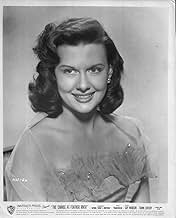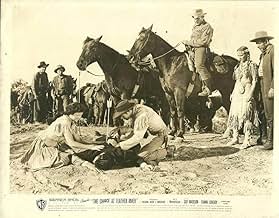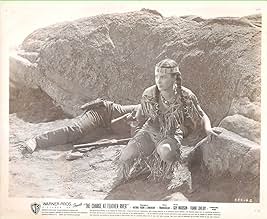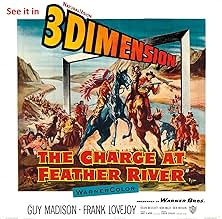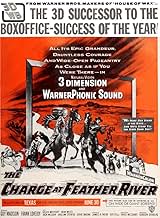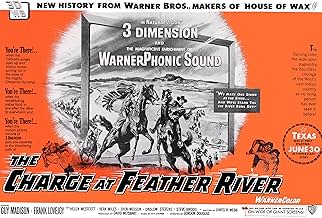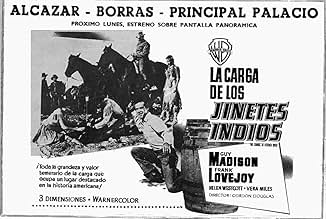अपनी भाषा में प्लॉट जोड़ेंIn Colorado territory, Miles Archer is asked by the cavalry at Fort Bellows to aid in rescuing two white women abducted by the Cheyenne and to provide security for the railroad construction ... सभी पढ़ेंIn Colorado territory, Miles Archer is asked by the cavalry at Fort Bellows to aid in rescuing two white women abducted by the Cheyenne and to provide security for the railroad construction teams.In Colorado territory, Miles Archer is asked by the cavalry at Fort Bellows to aid in rescuing two white women abducted by the Cheyenne and to provide security for the railroad construction teams.
फ़ीचर्ड समीक्षाएं
6bux
Slightly above average western drama with the emphasis on action. A cavalry commander (Madison) is forced to recruit from the guard house and set out on a mission to bring back white hostages the Indians have captured. All the expected sterotypes are present, and of course one of the hostages is a beautiful female. Since this one was originaly shot in 3D, be prepared to 'suffer those slings and arrows!'
Other commentators here have done an admirable job in addressing where "Charge at Feather River" fits in within the canon of Western movies, its similarity to "The Dirty Dozen" and other films of that genre, the use of 3-D effects, and even the origin of the Wilhelm scream. But what about the climactic, epic-making confrontation between Miles Archer (Guy Madison) and Chief Thunderhawk (Fred Carson)? In the action/adventure movies of the 1950s and 1960s, one knows the leaders will meet and fight it out. But when and where and how will it happen?
Thunderhawk has plenty of reasons to want to kill Archer himself. The whites are building a railroad through Cheyenne territory; their rescue effort has led to the death of Thunderhawk's bride-to-be. The cavalry troopers are occupying an island in the middle of the Feather River itself.
In the first charge, the Cheyenne have been repulsed. Their bodies float about the river. Stray horses amble about without direction. But the calm following this is deceptive. The Cheyenne prepare for another charge and this time Thunderhawk will personally take command.
At first, all goes well and a couple of the Guardhouse Brigade are picked off. Then, Thunderhawk commits his fatal mistake. At the head of about thirty to fifty braves, he veers off with only a half a dozen or so warriors to approach the island from the rear while the main bunch of Indians continues to hurl spears and to get shot, falling off their horses, and then bobbing in the river.
Thunderhawk, recognizable in his eagle feather headdress, leads his handpicked braves slowly up an embankment, on their bellies, in preparation for this "stealth" attack. But when they reach the crest of the embankment, above the river's edge, all goes wrong. They are seen too soon and all but Thunderhawk get shot down. Meanwhile, the main war party is beginning to back off.
Thunderhawk, without rifle or spear, cut off from all his men, draws his knife, preparing to do battle with Archer, one against one. Thunderhawk's very life now depends upon his skill with a knife. The bare-chested Cheyenne war chief, confident, powerful, motivated, eager for revenge and victory, squares off against Archer.
After only a few moments, Archer has maneuvered the chief to a slight earthen rise above the embankment, so that the daring, risk-taking, bold Cheyenne war chief stands a little bit above the cavalry officer. Archer goes for Thunderhawk's proud, taut, copper-bronze, native leader belly. As the knife goes in (off camera), Thunderhawk grunts in disbelief and topples, about to fall over the embankment. In a very clever shot, Guy Madison is seen looking over the embankment as Thunderhawk might have seen the view, his last before his death. Thunderhawk gives out a scream of terror as he tumbles down the embankment, splashing into the river. His horse makes way, only slightly, as the chief disappears under the water.
A valiant, determined, daring, native chief has lost his gamble.
Thunderhawk has plenty of reasons to want to kill Archer himself. The whites are building a railroad through Cheyenne territory; their rescue effort has led to the death of Thunderhawk's bride-to-be. The cavalry troopers are occupying an island in the middle of the Feather River itself.
In the first charge, the Cheyenne have been repulsed. Their bodies float about the river. Stray horses amble about without direction. But the calm following this is deceptive. The Cheyenne prepare for another charge and this time Thunderhawk will personally take command.
At first, all goes well and a couple of the Guardhouse Brigade are picked off. Then, Thunderhawk commits his fatal mistake. At the head of about thirty to fifty braves, he veers off with only a half a dozen or so warriors to approach the island from the rear while the main bunch of Indians continues to hurl spears and to get shot, falling off their horses, and then bobbing in the river.
Thunderhawk, recognizable in his eagle feather headdress, leads his handpicked braves slowly up an embankment, on their bellies, in preparation for this "stealth" attack. But when they reach the crest of the embankment, above the river's edge, all goes wrong. They are seen too soon and all but Thunderhawk get shot down. Meanwhile, the main war party is beginning to back off.
Thunderhawk, without rifle or spear, cut off from all his men, draws his knife, preparing to do battle with Archer, one against one. Thunderhawk's very life now depends upon his skill with a knife. The bare-chested Cheyenne war chief, confident, powerful, motivated, eager for revenge and victory, squares off against Archer.
After only a few moments, Archer has maneuvered the chief to a slight earthen rise above the embankment, so that the daring, risk-taking, bold Cheyenne war chief stands a little bit above the cavalry officer. Archer goes for Thunderhawk's proud, taut, copper-bronze, native leader belly. As the knife goes in (off camera), Thunderhawk grunts in disbelief and topples, about to fall over the embankment. In a very clever shot, Guy Madison is seen looking over the embankment as Thunderhawk might have seen the view, his last before his death. Thunderhawk gives out a scream of terror as he tumbles down the embankment, splashing into the river. His horse makes way, only slightly, as the chief disappears under the water.
A valiant, determined, daring, native chief has lost his gamble.
Absolutely superior 3D photography, possibly the best from that short-lived gimmick (saw it slack-jawed at a recent 3D Festival here in Los Angeles). Very clever and simple effects from yoeman director Gordon Douglas, who handily uses his B-movie angles to great effect in this little saga, with a flawless Guy Madison and Frank Lovejoy very, very good in their parts as rogue officers leading a ragtag band (a'la THE DIRTY DOZEN) to find (a'la THE SEARCHERS)a woman kidnapped (not exactly against her will) by Indians (the added twist: an incredibly evil performance by a likewise kidnapped sister, Vera Miles, looking like she just graduated from high school, who stops at nothing to halt the progress of Our Guys. Two stand-out scenes, even in 2D, is Lovejoy spitting INTO the camera to rid himself of a deadly snake (sounding a lot like Mel Blanc hawking up), and the first use of the infamous "Wilhelm Scream" - since used in literally hundreds of films (and actully re-mastered by Ben Buritt for LucasFilms' use - you can hear it much like that strange "oh-oh" titter in old situation comedy tracks - in all Warner Bros. films from this movie on, as well as RAIDERS OF THE LOST ARK. Listen for it (in CHARGE AT FEATHER RIVER it comes right after the inevitable "You OK, Wilhelm?" before he's ZAPPED by an arrow in the chest - one of many thrown at the audience in the film's compact running time).
I saw this movie in its original 3-D run in 1953 and never forgot it. Roughly based the actual Battle of Beecher's Island in Colorado, it's pretty exciting stuff. Some say that this is the movie that killed 3-D with Frank Lovejoy spitting into the face of the audience. I don't know about that, but I do know that I enjoyed it then and enjoyed it again recently on cable. And then, of course, this is THE movie with the Wilhelm Scream, made famous by latter day maestros such as George Lucas. No DVD version released yet...maybe in the not-too-distant future. The love story is sort of stupid and the comedy bits are not very funny, but I know I enjoyed it more than The English Patient, or just about anything that Merchant-Ivory ever released. I suppose the movie was produced to take advantage of Guy Madison's high visibility as TV's Wild Bill, very popular with the kiddies at the time.
Warner Brothers produced this 3D extravaganza that was the biggest commercial success for westerns in 1953. Guy Madison leads a band of guardhouse soldiers and misfits to rescue two white women being held by Indians, which essentially all there is to this film. The 3D format was in its early stages as a Hollywood gimmick to compete with the growing popularity of home television, and the effects work very well here. The rescuers make off with the ladies and are pursued by the Indians until the white men make their stand at an island in a creek bed. The Indian weaponry comes at the audience non-stop throughout, and a spray of tobacco juice aimed at a rattler is thrown in for good measure. Madison was quite popular as television's Wild Bill Hickock and is good as a displaced cattle rancher who is given his thankless task by the army. For all the film's polish and presentation, the movie was made in just three days.
क्या आपको पता है
- ट्रिवियाWILHELM SCREAM: A scream used for the character Private Wilhelm (recorded originally for Distant Drums (1951)), can be heard when he is shot in the leg by and arrow and painfully lets out a Wilhelm. This famous sound effect has since been re-used in many films, including the Star Wars, The Lord of The Rings and Indiana Jones films.
- गूफ़When Morgan sets Jennie free, she takes his revolver and then falls from the cliff, taking his revolver with her. In subsequent shots, however, Morgan has a pistol again.
- कनेक्शनFeatured in A Star Is Born (1954)
टॉप पसंद
रेटिंग देने के लिए साइन-इन करें और वैयक्तिकृत सुझावों के लिए वॉचलिस्ट करें
- How long is The Charge at Feather River?Alexa द्वारा संचालित
विवरण
बॉक्स ऑफ़िस
- US और कनाडा में सकल
- $36,50,000
- चलने की अवधि1 घंटा 35 मिनट
- पक्ष अनुपात
- 1.37 : 1
इस पेज में योगदान दें
किसी बदलाव का सुझाव दें या अनुपलब्ध कॉन्टेंट जोड़ें

टॉप गैप
By what name was The Charge at Feather River (1953) officially released in India in English?
जवाब

